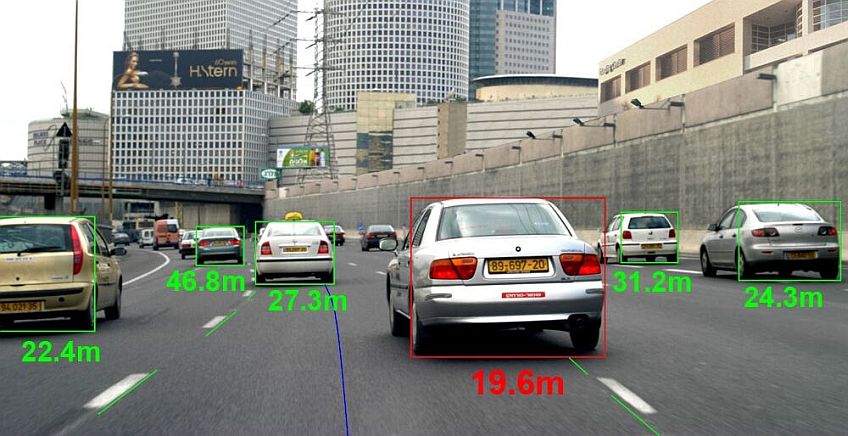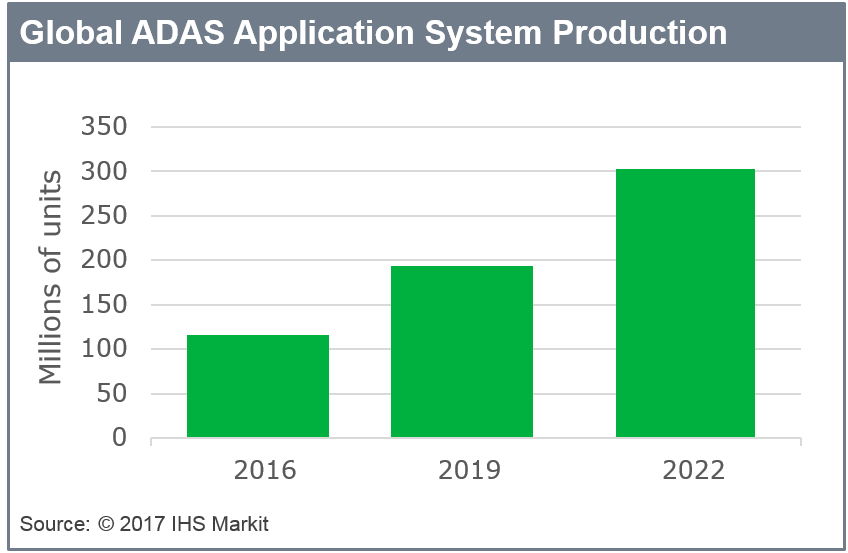Global ADAS Market to reach 302 Million Units in 2022
27 April, 2017
The growth will be driven by advances in sensor technologies including radar, camera and laser sensors (LiDAR) that will number more than 232 million units annually in 2022

Photo above: Mobileye ADAS demonstration
Global automotive applications of Advanced Driver Assist systems (ADAS) will surpass 302 million units annually in 2022, according to new analysis from business information provider IHS Markit (Nasdaq: INFO). In ADAS Applications and Sensors Report, IHS Markit forecasts that global ADAS growth will be led in part by new introductions of automated autopilot, driver monitoring systems and side and rear mirror cameras.
The growth will be driven by advances in sensor technologies including radar, camera and laser sensors (LiDAR) that will number more than 232 million units annually in 2022, the report says. These technologies will also enable higher levels of automated driving.
“Many OEMs have started offering partially automated systems that execute accelerating, braking and steering together,” said Aaron Dale, senior automotive analyst at IHS Markit and the report’s author. “These systems combine multiple sensors and multiple single-function ADAS features to allow the vehicle to drive, albeit under driver supervision. Combining these functions and sensors requires high level of integration and computing power.”

Complete 360-degree awareness
Current systems manage the driving task at low speeds as well as high and can complete lane changes with driver input. Future systems may use artificial intelligence to navigate more complex driving environments on their own. This functionality extends the integration of forward-sensing systems such as adaptive cruise control (ACC), lane keeping assist (LKA) and traffic sign recognition (TSR) by integrating blind spot information (BSI) and rear-sensing to provide complete 360-degree awareness.
Automated driving systems today have guided the industry into level 2 of the Society of Automotive Engineers definitions where constant driver supervision is required. The first level 3 capable systems are just around the corner, which will remove the need for constant driver supervision in certain circumstances, such as in traffic jams or on well-maintained stretches of highway. Europe and North America will see the first deployments of L3 technology, but consumer acceptance remains a key question on the path to widespread adoption.
Looking for the blind spots
Side and rear mirror cameras offer another opportunity for growth, IHS Markit says. While the technology for such systems readily exists and automakers have an appetite to deploy such systems, regulation has hindered widespread adoption. Japan was first to revise regulations in 2016 citing advances in camera quality, and other markets are expected to follow in the years to come in order to improve blind spot visibility, vehicle aerodynamics and provide additional driver support through the use of machine vision. As cameras add to the complexity and cost of vehicles, uptake is expected to be limited to well-equipped flagship models over the short term, with wider deployment in smaller cars likely in Japan especially.
Driver monitoring systems are intended to address driver distraction, fatigue and cognitive load that may negatively affect driver awareness or ability to react in a timely manner. Most systems today reference a multitude of sensors and measurements throughout the vehicle to infer driver fatigue or distraction, but the arrival of more advanced L3 driving systems has highlighted the need to understand the driver’s state more directly. This method of direct driver observation, using an interior camera sensor to observe eye movement and gaze direction, will allow the vehicle to effectively manage and ensure a safe transition between self-driving and driver-controlled operation.
New generation of LiDAR sensors
Sensors continue to be the primary enabler of these new safety and convenience features, and radar and camera maintain a strong position in the market throughout the forecast as capable incumbent sensing technologies. Advances in machine vision and machine learning give camera sensors unique utility, while new applications for 77 GHz radar are providing automakers with higher resolution awareness in the short to mid-range distances around the vehicle. A new generation of LiDAR sensors will offer useful complementary and redundant coverage as more highly automated driving systems come to market.
Posted in: Automotive , Autonomous Car , News



